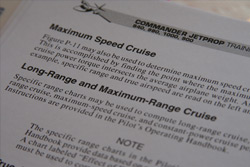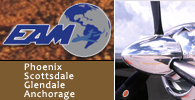TURBO COMMANDER PERFORMANCE


By Hugh Davis
As the weather improves, it is time to put the polishing rag away and start thinking about destinations in our Commanders. Whether it is a new place or a repeat business destination, it is also time to brush away the flying cobwebs and reacquaint ourselves with the performance of the Turbo Commander. As we get back up to speed we should not forgot that it is a federal air regulation that we complete a proper preflight by determining required runway lengths, fuel requirements, and weather planning for each flight.
Whenever Commander owners gather, the conversation seems to flow to runway requirements, en route performance, and fuel economics. In this article we will discuss all three.
A few years ago at a Twin Commander University, a gentleman asked me how much runway a Commander needs for takeoff. I thought for a moment, then said �Less than most turboprops.� I could have easily given him this detailed explanation:
New Commanders were delivered from the factory in two versions: those with TPE331-5 power, and those with TPE331-10s. Many of the Dash 5 aircraft have since been converted to Dash 10Ts.
For aircraft that were delivered with TPE 331-5s, the engines each produced flat-rated power of 717.5 horsepower on a standard day. If you have looked at the Two-Engine Takeoff Shaft Horsepower and Fuel Flow Rate Charts in your Aircraft Flight Manual, you probably noticed that max power is based on 682 horsepower instead of 717.5. This is due to certain accessories that may automatically limit operations to the lower power number. This chart should be reviewed on occasion, especially if you believe you are not receiving all the horsepower that the chart specifies for a given density altitude.

As in most standard aircraft, the higher the density altitude the longer the runway requirements for takeoff roll and to clear a 50-ft height. Rate-of-climb after clean up is reduced as well. For example, on a standard day normal takeoff distance for a 690B to clear a 50-ft height is about 2,000 ft. The distance will be even shorter if you use short-field takeoff speeds and techniques.
Again, most of us will not use this distance for much more than bragging rights. To be safe we need to factor in the accelerate-stop distance. At sea level on a standard day accelerate-stop distance is 3,300 ft, and accelerate-go distance is 2,900 ft.
Remember that this data was produced on a perfect day, with a perfect pilot, in a perfect plane. The AOPA Safety Foundation recommends takeoff and landing distance be increased 50 percent of the normal charted distance. At higher density altitudes performance will decrease, requiring longer runways. Those aircraft with Dash-10-powered engines should normally see better performance.
Reading the Twin Commander Community Forum (http://www.flightlevelsonline.com/phpBB/) there has been a considerable amount of discussion about climb speeds for the Commander. Bob Hoover set three time-to-climb records on April 27, 1978 in a Dash 5-powered Turbo Commander 690B. He climbed to 3,000 meters (9,843 ft) in 2:21 minutes, 6,000 meters (19,685 ft) in 5:16 minutes, and 9,000 meters (29,527 ft) in 9:43 minutes. Of course, this 690B was stripped down to the bare minimum with just enough fuel to get up and back down, with little reserve. It would be interesting to know what his climb speeds were.
The Pilot Operating Handbook (POH) states that the best rate of climb is 139 knots at sea level (135 knots for the JetProp) and then decreasing one knot per thousand as altitude increases. In many cases this best rate is a little uncomfortable for our passengers and the view over the nose is limited. Any increase in speed over best rate will decrease the rate of climb, but it also increases the true airspeed with a slight deduction in total time en route. Rate of climb and climb speed can also be controlled by outside factors such as ATC or terrain.
My experience on a standard trip is that I climb at 160 knots IAS until reaching 15,000 ft, then increasing pitch and reducing airspeed to maintain 1000 fpm or slightly less until I level off in the mid-20s. This is in a Dash 5-powered 690B. In the JetProps and Dash 10-powered 690As and Bs, I will climb at 170 knots IAS until into the 20s, then 1,000 fpm until leveling off in the high 20s.
In reviewing the cruise performance charts for the 690s and all the JetProps, it is safe to say that the higher you fly the longer the range. Also, there is some difference in range when using long-range cruise rather than max cruise. For example, at 25,000 ft. on a standard day, a 690B will get 75 more miles of range (1350 nmi) if the power is set for long-range cruise. One of the best improvements to the Commander is the longer wing on the JetProps, which allows for additional fuel. This increases the range for the JetProp 1000 to more than 2000 miles.
There have been some interesting stories from clients who have been to the Houston Learning Center. One owner bought his JetProp 900 (Dash 10-powered) here in the U.S. and flew it all the way to Australia via the Pacific. Other owners have taken their Commanders from the U.S. to Europe. All of these long-range trips where flown near the service ceilings of the aircraft.
A lot of the bookwork and diving into the performance charts for range and fuel calculations have been made a lot easier by flight-planning websites like FltPlan.com, FlightAware.com, Duats, and Jeppesen. Most sites have the performance data loaded into their computers, and at some of the sites you can fine-tune their data with your own derived data.
Even the guesswork as to how winds and fuel cost will affect your total operating cost can be factored in to your flight planning. For example, computed data may show that, in certain conditions when flying into a headwind, it might be more appropriate to fly at a lower altitude burning more fuel if total flight time will be less—therefore reducing total operating expenses—than when cruising at a higher altitude.
Poor descent planning can end up burning a considerable amount of fuel that you had saved by flying high. On your next flight monitor the fuel flow gauges during the descent. You will see that in the initial descent reducing the power to 300 HP, or around 30 percent, will reduce fuel flow (FF) to under 200 pounds per hour per engine. At lower altitudes you will see that the FF will continue to climb. Leveling the aircraft at 10,000 ft. or lower can easily increase the FF to more than 300 lbs per hour per engine. Most Commander pilots descend at a 1,500 fpm rate and 200 kts IAS. Torque will be around 300 HP, or 30 percent.
Since the last Commander rolled off the production floor in 1986 there has been a lot said about the performance of the Turbo Commander and what a great design it is. With the cost of ownership and fuel prices increasing, the design is still remarkably competitive.
During initial and recurrent training at the Houston Learning Center your instructor will spend time discussing the performance data of your aircraft and create specific scenarios based on your flying. You will be able to locate and use the performance charts to determine the benefits and limitations of the Turbo Commander.
So remember, until you have time for scheduling that recurrent training it is important to pull out the POH performance charts, hit the websites, and plan well for your next destination.
Good Flying!
Hugh Davis is an instructor at FlightSafety�s Twin Commander Learning Center in Houston.
Discuss this article in the forums...








